This post was guest authored by Stephanie Mackin, Archives Librarian in Special Collections at the Tampa Library
Growing up in a Greek and Italian household, I spent many days in the kitchen after school watching and learning how to make traditional meals and desserts. In the beginning, my role was mainly the designated dishwasher, but I will always remember the very first time I was allowed to crack an egg, measure milk in a cup, and hand mix a bowl to help my grandmother make her traditional Christmas cookies. After that, I was hooked and would beg my grandmother to teach me how to make numerous types of pies, cookies, cakes, and breads. Now that I am older, baking the desserts has become my official duty in the holiday family get togethers.
THE COOKBOOK
As the great-granddaughter of Greek and Italian immigrants, the traditions and history from both sides of my family have been passed down through the generations. My grandparents have always stressed the importance of remembering our heritage and the sacrifices that were made. So, when I began working on the Anthony P. “Tony” Pizzo collection, I was enamored to learn of the strong Italian/Sicilian influences that shaped Ybor City. Tony Pizzo, the grandson of Sicilian immigrants and the son of Paul Pizzo—who organized La Nuova Sicilia Lodge, the first chapter of the Sons of Italy organization in Florida—dedicated his life to documenting the history of Tampa and Ybor City. A significant portion of his research focuses on the Italian immigrants who were present during the early years of Ybor City.
THE RECIPE
While sorting through his archives, I came across a handwritten recipe titled “Dead Bone Cookies” and became instantly intrigued. [1] As a person interested in the macabre and baking traditional foods, I went in search of the historical and cultural context of these cookies. I found that Dead Bone Cookies, or “Ossi Dei Morti,” are traditional Italian cookies made for the Feast of the Dead or “Festa dei Mort”, which is during All Souls Day on November 2nd. The Feast of the Dead is a day to remember loved ones who have passed and to teach children not to be afraid of death by taking a trip to the cemetery with sweets and presents. Similar traditions exist in many cultures, such as the Day of the Dead “Dia de Los Muertos” celebrated in Mexico or Japan’s Obon Festival. [2] The ingredients in Dead Bone cookies can vary by the region of Italy, like in the Lombardy region, they add raisins, spices, and even orange juice to their “Pan dei Morti” or “Bread of the Dead” cookies. [3] With further research of the ingredients, I found that this version of the recipe is traditionally made in Sicily, which made complete sense that I would have discovered it amongst Pizzo’s papers. [4]
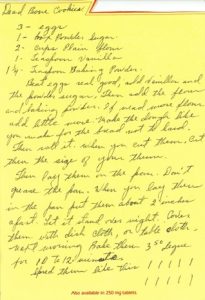
When it came to baking these dead bone cookies, I decided to follow the handwritten recipe only and avoided searching the internet for tips and tricks related to baking the cookies. However, I did have to do a quick search once I got to the second ingredient, a box of powdered sugar. With my family’s love of Costco, I only had a big bag of powdered sugar and needed to know how much was in a standard 1 lb. box of Domino powdered sugar – it turns out it is about 2 cups. From here, the ingredient portion was straightforward, and I began mixing all of my ingredients.
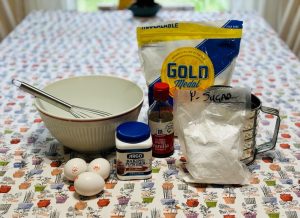
I did not encounter another issue until I got to the part about rolling the dough. Did the instructions mean to “roll it” with a rolling pin or “roll it” into one big tube? It was not very clear, so I went with my instincts and rolled it into a log shape and then sliced it into four parts. Then I rolled each of those four parts into a medium-length tube. I then sliced the tube into lengths the “size of my thumb” and laid them onto ungreased pans. I covered the pans with a dishcloth and prepared to let the dough sit out overnight, as per the instructions.
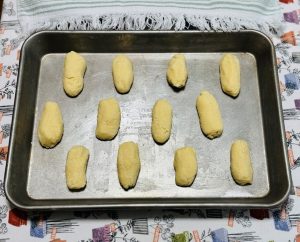
At this point, my once-chef partner strolled into the kitchen and gawked at my work declaring, “You cannot leave uncooked egg out overnight, you will give everyone salmonella!” After waving the instructions in his face, defiantly stating that I was following the instructions, and that no one would be forcing him to eat my salmonella cookies, I realized that there might be some truth to his uncooked egg rant. So, I went against my “no internet” policy and did some quick research.
I found that according to the USDA, uncooked eggs should not be left out at room temperature for more than two hours. It was recommended that if a dough with uncooked eggs needed to proof overnight, place it in a covered dish in the refrigerator. [5] Well, my partner was correct, but before I hung my head in shame and went to apologize, I wondered, how could a traditional Sicilian cookie recipe be around so long if it made everyone deathly ill every year? Turns out that chicken eggs in Europe are handled differently than they are in the USA. In Europe, chickens are vaccinated against salmonella, and the eggs are not washed, which keeps their protective cuticle on their shells. [6] This process allows for eggs to be stored at room temperature for up to two weeks. In the USA, chicken eggs are washed, and this removes their protective natural cuticle, which is why eggs must remain refrigerated to reduce the risk of salmonella. With that knowledge, and after a quick apology to my partner, I moved the cookie trays into the refrigerator to cold-proof overnight.
THE BAKE
The following morning, I took the trays out, and let them sit out for about 30 minutes, just to get the chill off of them and the dough to dry out a bit. I then set the oven to 350 degrees and baked each set of cookies for about 10 to 12 minutes. After a few minutes of baking, the dough began to separate. The top of the cookie remained pale in color and kept its bone like shape, but out from the base, a darker cookie began to spread out. As I started to take trays out of the oven, the “ungreased” instruction seemed like a bad idea, as the first batch of cookies were stuck to the baking pans. On the next batch, I quickly removed the cookies while they were still hot and set them on a cooling rack.

I decided to try one of the cookies while it was still fresh and warm from the oven. I was surprised by the various textures of the cookie. The top “bone” piece looked hard and dry but was chewy and sweet, and the bottom part of the cookie tasted very similar to a soft, plain sugar cookie. Overall, baking the recipe was a success and these cookies would certainly pair well with an espresso. Before I overindulged myself and ate all of the cookies at my kitchen table, I realized that there was a much more appropriate place to enjoy these.
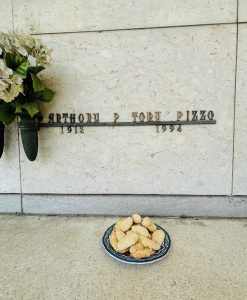
Even though it was not All Souls Day, I packed up the cookies and decided to pay my respects to Anthony P. “Tony” Pizzo. Thanking him for his research on and dedication to the Ybor City community. I am grateful for all that he has posthumously taught me about Tampa’s history and the Italian immigrants who influenced it. Grazie di cuore, Tony!
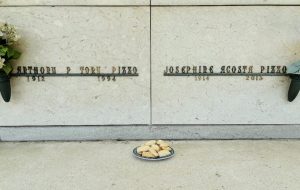
In Memory of Anthony P. “Tony” Pizzo and Josephine Acosta Pizzo
Learn more:
- Anthony P. “Tony” Pizzo collection
- Anthony P. “Tony” Pizzo digital collection
- L’Unione Italiana records
- L’Unione Italiana digital records
Want to read more posts like this one?
Explore our Baking the Archives series!
- Baking the Archives: Utilizing historical recipes in honor of National Homemade Bread Day
- Baking the Archives: A Pie for Pi Day
- Baking the Archives: Blueberry cake(ish)
- Baking the Archives: A sweet start for Fall
- Baking the Archives: Dead Bone Cookies
- Baking the Archives: Rum Omelet
References
[1] Food- Italian, Folder 12, Box: 37, Folder: 12. Anthony P. “Tony” Pizzo collection, MS-1982-01. USF Libraries – Special Collections.
[2] Favazzo, R. (2022, October 10). Sicilian bone biscuits of the dead: Recipe and curiosities about the dessert and its origins. SicilyAddict. https://www.sicilyaddict.it/en/blogs/blog/biscotti-ossa-dei-morti-siciliani-ricetta
[3] Savoring Italy. (2024, July 29). Pan dei Morti-bread of the dead cookies. https://www.savoringitaly.com/pan-dei-morti-bread-of-dead-cookies/
[4] The Italian Tribune. (2020, August 20). All saints and all souls day. https://italiantribune.com/all-saints-and-all-souls-day/#:~:text=In%20Italy%2C%20there%20are%20festivals,saints%20of%20the%20Catholic%20calendar.
[5] U.S. Department of Agriculture. (n.d.). Food Safety and Inspection Service. Egg Products and Food Safety | Food Safety and Inspection Service. https://www.fsis.usda.gov/food-safety/safe-food-handling-and-preparation/eggs/egg-products-and-food-safety#:~:text=The%20USDA%20does%20not%20recommend,that%20Salmonella%20may%20be%20present.
[6] Bichell, R. E. (2014, September 11). Why the U.S. chills its eggs and most of the world doesn’t. NPR. https://www.npr.org/sections/thesalt/2014/09/11/336330502/why-the-u-s-chills-its-eggs-and-most-of-the-world-doesnt